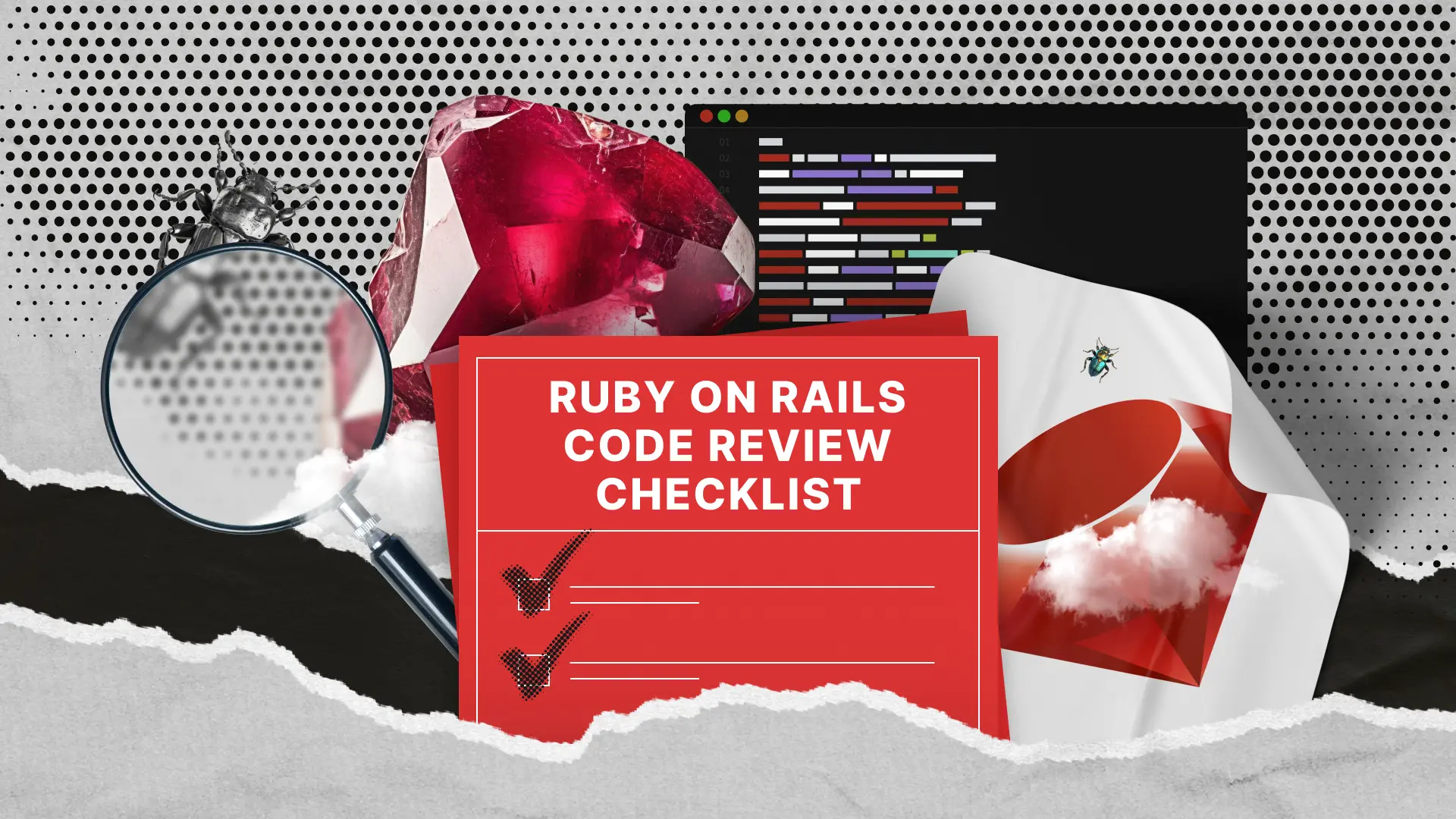Ruby on Rails (RoR) remains one of the most popular frameworks for rapid web development, but apps built with RoR require careful reviews to maintain reliability as they grow. At Redwerk, we’ve built, audited, and optimized Rails apps for over a decade. This Ruby on Rails code review checklist encapsulates our proven approach to preventing performance bottlenecks, patching security gaps, and ensuring a clean, maintainable codebase.
Preliminary Checks
Before inspecting a single method or model, set the stage for a productive review. Preliminary checks clarify objectives and streamline collaboration from the start. Skipping these checks can lead to missed context, overlooked dependencies, and an inefficient review process.
Gather Requirements & Architecture:
- Review project documentation: features, architecture diagrams, and deployment strategies
- Identify any critical modules (e.g., payment processing, real-time features) that demand extra scrutiny
Collect Codebase & Docs:
- Ensure you have the latest code from version control (Git, GitHub, or GitLab)
- Gather relevant documentation: API specs, DB schemas, and config files
- Look at issue trackers to spot recurring bugs or feature requests
Define Review Goals:
- Choose focus areas: security, scalability, maintainability, or all of the above
- Outline success criteria: fewer vulnerabilities, better response times, etc.
Environment Setup:
- Mirror production configurations for accurate testing
- Confirm you have access to the necessary databases and external services
- Use the same Ruby and Rails versions as production
Tool Selection:
- Code Quality: RuboCop for style checks
- Security: Brakeman for static analysis
- CI Integration: Automate checks on each commit or pull request
Code Quality & Maintainability
Readable, well-structured code scales faster and handles updates without causing drama. It also reduces onboarding time for new developers, ensuring a steady knowledge transfer within the team. By establishing consistent coding standards, you create a solid foundation that can adapt as project requirements evolve.
Follow Rails & Ruby Style:
- Align with established style guides (e.g., Ruby Style Guide)
- Keep naming consistent: singular model names, snake_case for methods
Keep Methods & Classes Tidy:
- Adhere to the single responsibility principle—avoid mega-controllers or bloated services
- Split large classes into modules or service objects where logical
Avoid Duplication:
- Factor out repeated logic into helpers, concerns, or shared service objects
- Use DRY code to reduce maintenance headaches and bugs
Error Handling:
- Rescue exceptions consistently, providing user-friendly messages
- Don’t expose sensitive system details in logs or error pages
Documentation & Comments:
- Document public methods with brief RDoc or YARD comments
- Remove outdated comments that no longer reflect the code
Testing & Coverage:
- Ensure RSpec or MiniTest covers critical paths
- Check coverage for edge cases, not just the “happy path”
Syntax & Language Constructs
Ruby offers expressive features that can shorten code, but be cautious of hidden traps. Overusing certain shortcuts or metaprogramming techniques can lead to unreadable and error-prone code. Consistent syntax helps your team quickly understand and maintain even the most complex logic.
Leverage Ruby Idioms:
- Use symbols for hash keys ({ user_id: 42 }), and avoid unnecessary string literals
- Stick to do…end vs. {} consistently for blocks
Control Flow & Methods:
- Use guard clauses (return unless current_user) instead of nested ifs
- Keep methods small and self-explanatory
Blocks & Iterators:
- Favor higher-order enumerators (map, select) for clarity
- Avoid triple-nested loops; break large tasks into smaller methods
Rails Conventions:
- Pay attention to the MVC pattern: keep business logic out of controllers
- Use ActiveModel validations for data integrity
Exception Usage:
- Raise exceptions only for truly exceptional cases
- Provide meaningful error messages to simplify debugging
Security Best Practices
RoR offers solid security defaults, but oversight can undermine them. Overlooked vulnerabilities can escalate into serious breaches, jeopardizing user trust and regulatory compliance. By following a structured approach, like the one outlined in our security code review checklist, you can systematically identify and mitigate potential weaknesses early on.
Strong Parameters:
- Whitelist fields in controllers to block malicious input
- Rely on mass assignment protections to guard sensitive attributes
SQL Injection Prevention:
- Use Rails query methods (find_by, where) with symbol keys
- Avoid raw SQL; if you must, sanitize inputs carefully
XSS & CSRF Defenses:
- Don’t bypass Rails’ escaping with raw or html_safe unnecessarily
- Keep protect_from_forgery active in controllers
Authentication & Authorization:
- Use libraries like Devise, CanCanCan, or Pundit for authorization
- Validate user roles before accessing restricted resources
Data Protection:
- Don’t store passwords or keys in the repo—use Rails-encrypted credentials
- Comply with relevant privacy laws (e.g., GDPR)
Regular Security Audits:
- Automate scans with Brakeman
- Keep an eye on gem updates—patch vulnerabilities promptly
Performance Optimization
A sluggish Rails app will inevitably lose users. Keeping response times low demands efficient data handling, caching, and background processing. For instance, while building a large-scale cleaning marketplace for CleanAgents, we optimized queries, added targeted caching, and implemented background jobs to handle intensive operations. Below are some of the best practices we find essential.
ActiveRecord Efficiency:
- Use select to limit columns instead of SELECT *
- Avoid N+1 queries with includes or eager_load
Caching:
- Implement fragment caching, Russian doll caching, or low-level caching
- Explore Redis or Memcached to store frequently accessed data
Background Jobs:
- Offload long-running tasks to Sidekiq, Resque, or Delayed Job
- Track queue processing time to spot bottlenecks
Optimizing Views:
- Move heavy computations out of templates
- Serve assets via a CDN for faster load times
Profiling & Monitoring:
- Use New Relic, Skylight, or Scout to identify performance bottlenecks
- Regularly profile SQL queries with EXPLAIN
Database Interaction
Fine-tuning your database logic is crucial in Ruby on Rails. Suboptimal queries and neglected schema considerations can lead to performance bottlenecks, data inconsistencies, or security loopholes. Below are several key practices that will help keep your application’s database interactions efficient and reliable.
Query Construction:
- Stick to where, find_by, pluck for data retrieval
- Keep custom SQL limited to specialized cases and test them thoroughly
Transactions:
- Group-related DB operations in transactions for atomic changes
- Roll back on exceptions to preserve data integrity
Indexing & Constraints:
- Add indexes to columns used in WHERE clauses or JOINS
- Enforce foreign key constraints to maintain referential integrity
Batch Operations:
- Use find_each or in_batches for large datasets to avoid memory bloat
- Leverage background jobs for chunk processing if needed
Migrations:
- Write reversible migrations
- Confirm migrations in a staging environment before production
Version Control & Collaboration
Solid Git workflows will keep your Rails projects stable, and your team in sync. By clearly defining branching strategies and commit practices, you minimize merge conflicts and ensure traceability. Encouraging prompt, constructive code reviews fosters a culture of quality and speeds up overall development cycles.
Branching Strategy:
- Use a consistent approach (Git Flow, GitHub Flow, trunk-based)
- Merge often to avoid massive, conflict-heavy branches
Commit Discipline:
- Keep commits small and topic-focused
- Write clear messages detailing the “what” and “why”
Pull Requests & Code Reviews:
- Provide thorough descriptions and link relevant tickets
- Discuss potential side effects or database migrations
CI/CD Integration:
- Automate RuboCop, RSpec, and Brakeman checks per PR
- Keep main branches deployable at all times
Release & Tagging:
- Tag stable releases (e.g., v2.1.0)
- Maintain a concise changelog for each release version
Compliance
Legal and organizational requirements must never be overlooked. Non-compliance can lead to heavy fines, reputational damage, or even service shutdowns. By integrating compliance checks into your development pipeline, you ensure long-term stability that protects both your business and your users.
Regulatory Standards:
- If handling personal data, verify GDPR and/or CCPA compliance
- For healthcare or finance, consider HIPAA or PCI-DSS guidelines
Security Updates:
- Stay on top of Rails security patches
- Track gem versions to avoid known vulnerabilities
Data Privacy & Auditing:
- Encrypt sensitive data at rest and in transit
- Log relevant user actions to detect unauthorized access
Open-Source Licenses:
- Review licenses for third-party gems
- Comply with usage terms to avoid legal complications
The Bottom Line
A robust Rails code review checks more than just syntax; it ensures your application is secure, performant, and future-proof. By systematically following each step—preliminary setup, syntax audits, security checks, performance tuning, and compliance—you’ll ship code that’s both easy to scale and safe to deploy.
At Redwerk, we provide quality RoR development services, helping businesses across North America and Europe create new revenue streams with robust marketplaces. We’ve audited Ruby on Rails solutions for government agencies, green tech startups, online marketplaces, and digital media platforms—pinpointing hidden code smells and security risks early on.
Do you have questions or need more hands-on support? Contact us at Redwerk. We’ll work together to help your RoR project reach its full potential.


